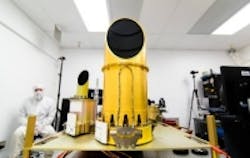OSIRIS-REx asteroid sampling spacecraft features multi-camera vision system
Set to launch today, September 8, NASA’s OSIRIS-REx spacecraft, which is being launched on a mission to study asteroid 101955 Bennu, features threehigh-resolution cameras that are based on CCD detectors.
Known asOCAMS (OSIRIS-REx Camera Suite), the vision system will act as the “retinas” for the OSIRIS-REx mission. The system was developed by the University of Arizona along with Teledyne DALSA, and was designed, constructed, and tested over the last four years to behave in a manner similar to human eyes, from spotting the target asteroid from more than a million miles away to monitoring the sampling process just 10 feet from the surface of the asteroid, according to Teledyne DALSA.
There are three high-resolution cameras, all of which are space-qualified and radiation-hardened CCD detectors from Teledyne DALSA, that comprise the OCAMS system:
- PolyCam:An 8-inch telescope that will acquire images during the approach to Bennu, as well as high-resolution images once in formation.
- MapCam:MapCam will acquire images and search for satellites around the asteroid. It will map the asteroid in four different colors, provide information on Bennu’s shape, and provide high-resolution images of the sample site.
- SamCam:SamCam will continuously document the sample acquisitions.
OSIRIS-REx is set to reach Bennu in 2018 and return a sample to Earth in 2023. The goal of the mission is to “return pristine carbonaceous material from the early Solar System.” This material,according to the mission site, will provide important clues to the origin of life on Earth and the likelihood that life may have originated elsewhere in our solar system.
"Our mission tries to attempt a lot of things at the same time," OCAMS instrument scientist Bashar Rizk said. "Navigation, mapping, reconnaissance, sample site selection, sampling — we do it on the same trip, so we need to understand what is going on at the asteroid at all times, so we can make decisions in real time when we're there. The most important goal of these cameras is to maximize the chances of successfully bringing back a sample."
In addition to the CCD sensors, Teledyne also contributed to the mission in other ways, as two of its other subsidiaries also contributed. Teledyne Optech designed the OSIRIS-REx Laser Altimeter (OLA) which will scan Bennu’s surface and create a high-resolution 3D map of the entire asteroid, while Teledyne Scientific provided a visible-infrared detector to the OSIRIS-REx Visible and Infrared Spectrometer (OVIRS) that will produce spectral maps of the asteroid’s surface that determine the mineral and organic content of Bennu.
View more information on theOSIRIS-REx mission.
View the Teledyne DALSA press release.
Share your vision-related news by contactingJames Carroll, Senior Web Editor, Vision Systems Design
To receive news like this in your inbox, click here.
Join ourLinkedIn group | Like us on Facebook | Follow us on Twitter
Learn more: search the Vision Systems Design Buyer's Guide for companies, new products, press releases, and videos
Join ourLinkedIn group | Like us on Facebook | Follow us on Twitter
Learn more: search the Vision Systems Design Buyer's Guide for companies, new products, press releases, and videos
About the Author

James Carroll
Former VSD Editor James Carroll joined the team 2013. Carroll covered machine vision and imaging from numerous angles, including application stories, industry news, market updates, and new products. In addition to writing and editing articles, Carroll managed the Innovators Awards program and webcasts.
